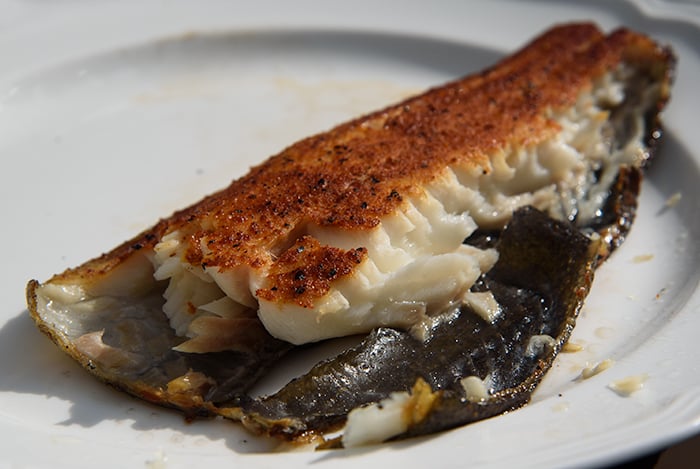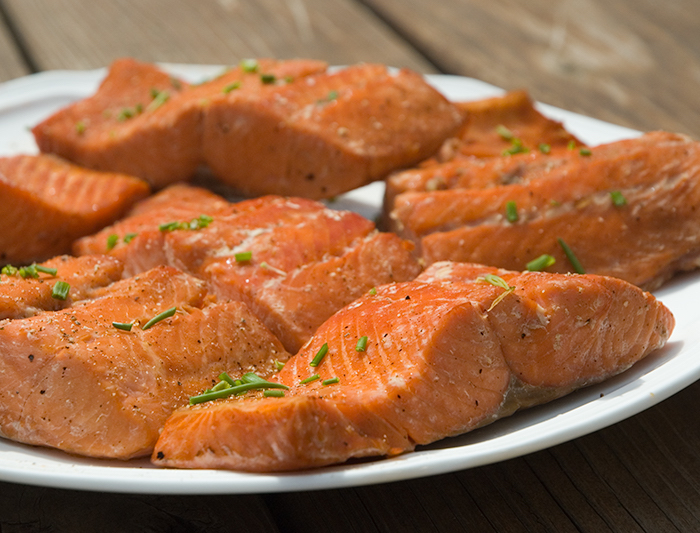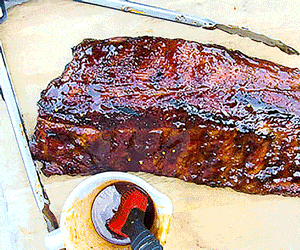That’s sable (a.k.a. black cod) in the photo, but this dry brined hot smoked fish recipe works with salmon and just about any fish. Simply dry brine (lightly salt) the fish before cooking. It’s similar to soaking the fish in salt water (wet brining), but without the water. Click here for a classic wet brined fish recipe if you want to go that route.
I like serve this dry brined hot smoked fish as an entrée while warm. It’s also great as an appetizer at room temperature on a platter. Served that way, guests can flake it on bagels with cream cheese, capers, and onion. Or enjoy it with bagel chips, pita chips, crackers, toast points, or rye toast, perhaps with a dollop of horseradish cream sauce. Once hot smoked, the fish keeps well at room temp for a few hours thanks to the salting and cooking.
This dry brined hot smoked fish recipe also pairs well with small boiled potatoes. Sliced the spuds in half, top them with sour cream or the horsey sauce above, and served with the smoked sable or salmon. Another wonderful use is to mix the fish in with scrambled eggs, omelets, or risotto. One of the best things about this dry brined hot smoked fish recipe is that it can be used in so many ways.
If you want to show off, smoke a whole side of fish. It makes an impressive presentation and is no more difficult than smoking smaller pieces.
Makes:
Takes:
Equipment
- 1 sheet plain white printer paper
Ingredients
- 2 pounds fresh skin-on fish fillet, such as salmon or sable or 4 sections of the fillet, each about 8 ounces cut from back to belly
- 2 tablespoons Meathead’s Memphis Dust
- 1 tablespoon Morton Coarse Kosher Salt
These recipes were created in US Customary measurements and the conversion to metric is being done by calculations. They should be accurate, but it is possible there could be an error. If you find one, please let us know in the comments at the bottom of the page
Method
- Prep. Remove the scales but leave the skin on. Don't worry if there are a few scales left on the skin. You will be removing the skin eventually. Run your fingers over the flesh of the fish and make sure all the pin bones are gone. If not, drape the fish over the edge of a bowl so the bones stick out, and yank them with tweezers or needle-nose pliers.
- For a whole fillet, cut the meat from back to belly (crosswise) into 8-ounce strips, each about 3-inches wide. Sometimes the lining of the belly of the fish has a milky membrane on it. With a sharp filleting knife, remove it. It can get leathery when you cook.
- Flavor. Cut pieces of plain white printer paper about the same size as each piece of fish and place the fish on the paper, skin side down. Sprinkle on the salt and Meathead’s Memphis Dust. If you are using a commercial rub that has salt in it, skip the additional salt.
- Fire up. Get the smoker started, or setup your grill in a 2-zone configuration and get the indirect zone up to about 225°F.
- Cook. Place the fish on a rack on your grill or smoker so the pieces are not touching each other. Add the smoking wood if you're using a grill. Start spot checking the internal temp after about 30 minutes. As the meat approaches doneness, 125 to 130°F in the thickest part, droplets of milky liquid will often come to the surface. Some cooks call them boogers, but they are actually a protein liquid called albumin from within the muscle fibers. It looks gross, but it's OK. You can brush it off with a wet brush if you want. Remove the meat when it reaches about 125 to 130°F internal temp. No more than 135°F. Total cooking time will be about 60 minutes, depending on the actual temperature of your smoker and the thickness of the fish.
- Cool. Remove the fish and let them cool until you can handle them. Then peel off the paper, and the skins should come right off with it.




High quality websites are expensive to run. If you help us, we’ll pay you back bigtime with an ad-free experience and a lot of freebies!
Millions come to AmazingRibs.com every month for high quality tested recipes, tips on technique, science, mythbusting, product reviews, and inspiration. But it is expensive to run a website with more than 2,000 pages and we don’t have a big corporate partner to subsidize us.
Our most important source of sustenance is people who join our Pitmaster Club. But please don’t think of it as a donation. Members get MANY great benefits. We block all third-party ads, we give members free ebooks, magazines, interviews, webinars, more recipes, a monthly sweepstakes with prizes worth up to $2,000, discounts on products, and best of all a community of like-minded cooks free of flame wars. Click below to see all the benefits, take a free 30 day trial, and help keep this site alive.
Post comments and questions below
1) Please try the search box at the top of every page before you ask for help.
2) Try to post your question to the appropriate page.
3) Tell us everything we need to know to help such as the type of cooker and thermometer. Dial thermometers are often off by as much as 50°F so if you are not using a good digital thermometer we probably can’t help you with time and temp questions. Please read this article about thermometers.
4) If you are a member of the Pitmaster Club, your comments login is probably different.
5) Posts with links in them may not appear immediately.
Moderators